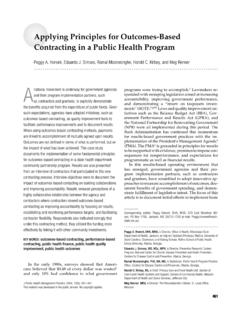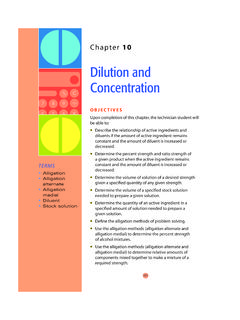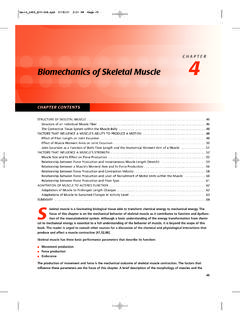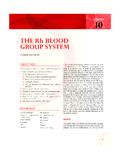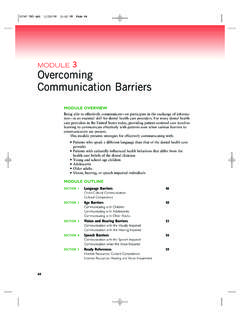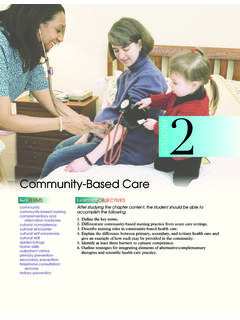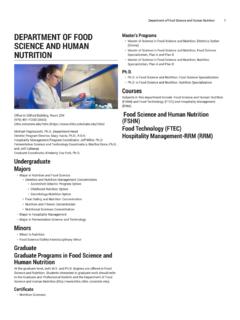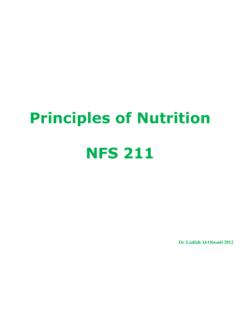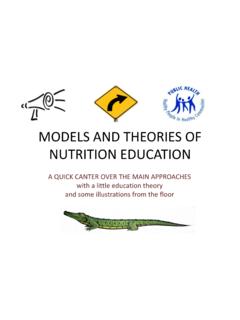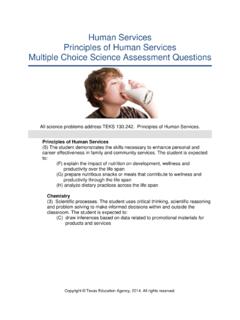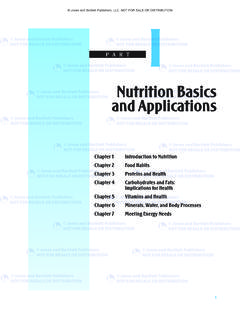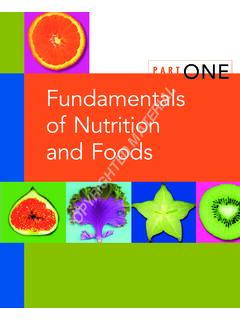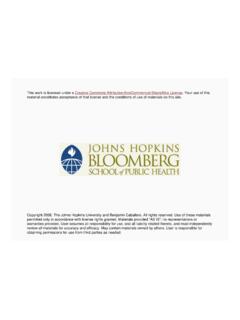Transcription of Principles of Nutrition - Lippincott Williams & Wilkins
1 UNIT ONEP rinciples of Nutrition 1 Nutrition in NursingTRUEFALSEUPON COMPLETION OF THIS CHAPTER, YOU WILL BE ABLE TO Describe how nutritional care can be approached using the nursing careprocess. Describe the rule of thumb formula for calculating ideal body weight for menand women based on height. Discuss disadvantages of using albumin as an indicator of nutritional status. Discuss alternatives to the term diet. Explain why an alternative term to diet is nurse s role in Nutrition is to call the status is the balance between nutrient intake a client if he/she is on a diet may not be of much value indetermining usual in weight reflect acute changes in nutritional person can be malnourished without being only cause of a low serum albumin concentration is Significant weight loss is 5% of body weight in 1 who take five or more prescription or over-the-countermedications or dietary supplements are at risk for nutritional handouts that list foods to avoid and foods to choose arevaluable teaching tools because they provide explicit dos and don signs and symptoms of malnutrition develop only after othersigns of malnutrition are apparent ( , abnormal lab values, weightchange).
2 4 UNIT 1 Principles of NutritionBased on Maslow s Hierarchy of Needs, food and Nutrition rank on the same level asair in the basic necessities of life. Obviously, death eventually occurs without food. Butunlike air, food does so much more than simply sustain life. Food is loaded with per-sonal, social, and cultural meanings that define our food values, beliefs, and food nourishes the mind as well as the body broadens Nutrition to an art as wellas a science. For most people, Nutrition is not simply a matter of food or no food butrather a question of what kind, how much, and how often. Merging want with needand pleasure with health are key to achieving optimal nutritional achieve optimal nutritional status, intake may need to be adjusted upward ordownward. For instance, when the goal is recovery from illness or surgery, nutritiontherapy focuses on meeting increased needs for calories, protein, and other who fail to meet their nutritional needs may experience prolonged or compli-cated recovery from illness, and their responses to medical treatments and drug thera-pies may be diminished.
3 In wellness settings, when optimal nutritional status meansdisease prevention, the nutritional focus is frequently to ensure that intake does not exceed requirement. The emphasis is on avoiding excesses of calories, fat, saturated fat,cholesterol, and sodium to reduce the risk of chronic diseases such as heart disease, hypertension, diabetes, and obesity. However, these settings do not have mutually ex-clusive nutritional priorities. Some hospital patients require restrictive diets ( , low-sodium diet), and some wellness clients have nutrient intakes below their requirements( , not enough calcium or fiber). Therefore, a priority for all clients is to consumeor obtain an adequate and appropriate intake of calories and nutrients based on theirown individual what is an adequate and appropriate intake of calories and nutrients and howto achieve that intake is determined by analyzing data to identify actual or potentialnutritional problems.
4 The decision-making process continues with goal setting, im-plementing a plan, and evaluation. While the dietitian or diet technician may shouldermost of the responsibility for the nutritional care of hospitalized patients deemed to beat moderate to high nutritional risk, low-risk hospitalized patients and clients in othersettings ( , home health, corporate wellness, parish nursing) may be relegated to thenurse. In addition, it may be the nurse who screens clients to determine the existinglevel of risk and who reinforces diet counseling. As such, nurses are intimately involvedin all aspects of nutritional chapter focuses on the importance of Nutrition in nursing practice. The nurs-ing processis used to illustrate how Nutrition is integrated into nursing in the real situations are described to show practical CARE PROCESSWhat does the client need?
5 What can you or others do to effectively and efficiently helpthe client meet his or her needs? What criteria will you use to judge success? These andsimilar questions are the foundation of the decision-making process, whether the focusis on general nursing or specifically on Nutrition . Nutritional Status:the state of balancebetween nutrientsupply (intake) anddemand (require-ment). An imbal-ance betweenintake and require-ment can result inovernutrition all settings, it is appropriate to evaluate the client s nutritional status so that appro-priate goals and interventions can be devised to correct actual or potential status can be assessed by looking at a few or many criteria. Exactly whichcriteria are evaluated and how the results are interpreted depend on the particular pop-ulation and setting as well as the availability of time and resources.
6 Although everyoneagrees that it is important to identify actual and potential nutritional problems, thereis no universally accepted, definitive tool to do so. Often professional judgment is asimportant as objective process of assessment involves gathering and analyzing data. Nurses are in anideal position to screen clients for nutritional problems through an initial nursing his-tory and physical examination. Clients deemed at low or no risk for nutritional prob-lems may need only to be monitored for any deterioration in nutritional status. Clientsfound to be at moderate or high risk are usually referred to a dietitian for a compre-hensive nutritional assessment (see Connectionwebsite for in-depth assessment crite-ria). It is important to remember that nutritional risks may exist that simply were notevaluated and that a person s relative risk can change.
7 Here are some key questions the Client at Nutritional Risk Because of Health Problems?A positive response to any of these questions may indicate the need for nutritionintervention:Does the client have a medical condition that may benefit from Nutrition therapysuch as diabetes or hypertension?Do physical complaints interfere with the client s intake such as difficulty chewingand swallowing, anorexia, heartburn, nausea, vomiting, or pain?Does the client have increased needs? For instance, nutritional needs increase inresponse to pregnancy, fever, sepsis, thermal injuries, skin breakdown, cancer,acquired immunodeficiency syndrome (AIDS), major surgery, and the client losing nutrients as in the case of malabsorption, diarrhea, and certainrenal diseases?CHAPTER 1 Nutrition in Nursing5 Career ConnectionWhat is the nurse s role in facilitating nutritional care?
8 Communicate with the registered dietitian (RD). Serve as a liaison between the physician and the RD. Identify clients who may benefit from programs such as Meals on Wheels. Request a referral to a speech therapist. Confer with the discharge planner, social services worker, and physical or : an in-depth analysis of aperson s nutritionalstatus. In the clini-cal setting, nutri-tional assessmentsfocus on moderate-to high-risk patientswith suspected orconfirmed protein-energy 1 Principles of NutritionIs the Client at Nutritional Risk Because of Intake?Obtaining reliable and accurate information on what the client usually eats is far moredifficult than it sounds. Eating is highly personal and people often get defensive whenquestioned about their eating habits. Although the nurse may only be required to fill ina blank space next to the word diet, simply asking the client Are you on a diet?
9 Willprobably not give accurate or sufficient information to determine what the client of all, a client may interpret that leading question as You should be on a diet. Ifyou re a good patient you ll tell me you follow a diet. A better question would be, Doyou avoid any particular foods? or Do you watch you eat in any way? Even the term meal may elicit a stereotypical mental picture. Questions to consider includeHow many meals and snacks do you eat in a 24-hour period?This question helps to es-tablish the pattern of eating and identifies unusual food habits such as pica, foodfaddism, eating disorders, and meal you have any food allergies or intolerances, and, if so, what are they?The greater thenumber of foods restricted or eliminated in the diet, the greater the likelihood ofnutritional deficiencies. This question may also shed light on the client s need fornutrition counseling.
10 For instance, clients with hiatal hernia who are intolerant ofcitrus fruits and juices may benefit from counseling on how to ensure an adequateintake of vitamin types of vitamin, mineral, herbal, or other supplements do you use and why?Amultivitamin, multimineral supplement that provides 100% or less of the DailyValue offers some protection against less than optimal food choices. Folic acid insupplements or fortified food is recommended for women of childbearing age;people over age 50 are encouraged to obtain vitamin B12from fortified foods orsupplements. However, potential problems may arise from other types or amountsof supplements. For instance, large doses of vitamin A, B6, and D have the poten-tial to cause toxicity symptoms. Iron supplements may decrease zinc absorptionand negatively impact zinc status over concerns do you have about what or how you eat?
